TRACE
n. (1) track left by person or animal walking or running, footprints or other visible signs of course pursued.
n. (2) visible or other sign of what has existed or happened.
Traces are everywhere

Marian Bijlenga, Sampler dots (with red), 2004, dyed horsehair, fabric
This is what Sue Clarke says about Marian's work on her blog...
I find Bijlenga’s work interesting because it’s almost entirely made of holes, with small elements held together by horsehair and appearing to float in space. They’re always mounted a pin’s length away from the wall, and never behind glass. There’s always the slight possiblity of movement, and the shadows play a significant part too.
She [Marian] writes: ‘For me, holes are not empty. When I see holes, for example on a leaf, I see the trace made by a parasite. Holes are leftovers from things that happened before. Holes in my work form new shapes.’ All her work is held together by holes, spaces that make something out of nothing, or out of an absence.
I have found that the idea of trace is present in so many of the investigations being done by other students - Agot is looking at stains and what they represent, Treld is looking at memory - and now Sue's holes and perforations are 'leftovers from things that happened before'.
Using pva as a drawing material and finding imagery in trace memories
One type of trace is the memory of someone loved - they leave vestiges behind that remind you of them. Thinking of this I developed imagery that is, to me, reminiscent of someone close to me.
 By using this imagery with pva lines and graphite powder I have made a set of drawings where I peel the pva line off the backing film and place them side by side.
By using this imagery with pva lines and graphite powder I have made a set of drawings where I peel the pva line off the backing film and place them side by side.
So I am using trace materials to represent a trace memory.
I'd like to know what you think of these sample drawings - please leave a comment.
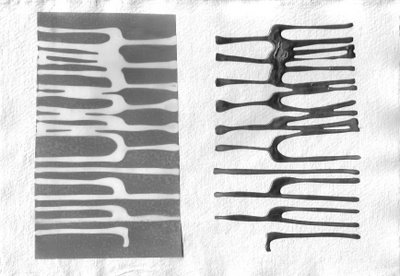
Layering traces...
The investigation was process led initially - so the use of layering and tracing paper developed some of the ideas - combining the ant-like text drawing with traces left by pva and graphite lines.
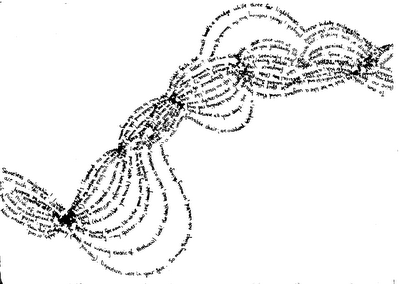
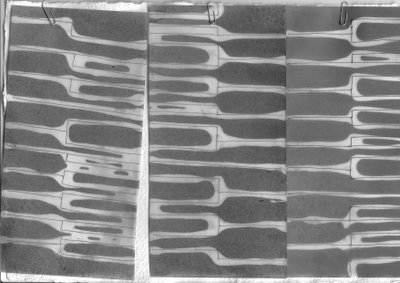

Trace - through literature
When I started looking into trace a friend (an artist) got excited about the subject and began throwing information in my direction.
Amongst it all was a beautiful poem by Dannie Abse with whom Barbara once did a reading of this very poem.
So here it is now, because it forms the basis of some work
To own nothing, but to be-
like a vagrant wind that bears
faintest fragrance of the sea
or, in anger, lifts and tears
yet hoards no property;
I praise that state of mind:
wind, music, and you, are such.
All the visible you find
(the invisible you touch)
alter, and leave behind.
To pure being you devote
all your days. You are your eyes,
seemingly near but remote.
Gone, now, the sense of surprise,
like a dying musical note.
Like fragrance, you left no trace,
like anger, you came my way,
like music, you filled the space
(by going, the more you stay).
Departures were in your face.
Dannie Abse
Trace Element Week 1
TRACE n. (1) track left by person or animal walking or running, footprints or other visible signs of course pursued.
n. (2) visible or other sign of what has existed or happened .

I am looking into TRACE - thinking about how we leave a trace in the landscape, how that trace erodes over time and the memory we hold of it. Thinking about the afterimage of a sparkler or car lights along Park Lane at night or time-based drawings with light.
TRACE, perhaps, can also be about obscuring one's identity - masking it with layer upon layer of semi-opaque material. It could conversely be about revealing identity. I am interested to see how far one can go in covering up something and still retain an understanding of what it is. Or how much one must reveal information so that the image/text can be read.
Over the next few months I shall be exploring the idea of TRACE and I welcome your comments!
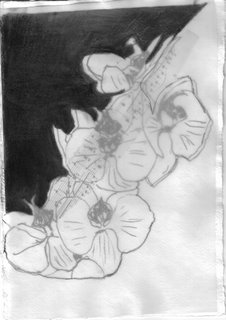
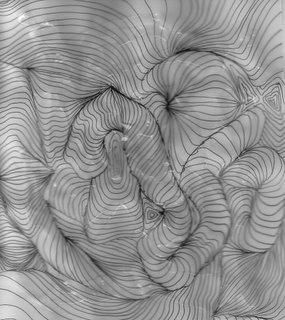
These drawings will serve to show my startpoint. I have been using pva glue, pen and graphite on tracing paper and drafting film. I like the transparency of the pva, the translucence of the film and the reflective quality of graphite. A combination of materials allows me to disguise or reveal other images.
I want to use these materials to develop the idea of trace, possibly in time-based drawing using light or in temporary works in the environment. I am also interested in finding the moment when an image loses its readability - how far can I go in concealing it before one's perception of the image or the sense of text is lost.



















